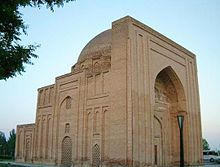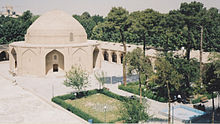Sufi lodge
| Part ofa seriesonIslam Sufism |
|---|
 |
|
|
ASufi lodge[a]is a building designed specifically for gatherings of aSufi brotherhoodortariqaand is a place for spiritual practice and religious education.[1]They include structures also known askhānaqāh,zāwiya,ribāṭ,dargāhandtakyadepending on the region, language and period (see§ Terminology).[2][3]InShia Islam,theHusayniyyahas a similar function.[4][5]
The Sufi lodge is typically a large structure with a central hall and smaller rooms on either side.[3]Traditionally, the Sufi lodge was state-sponsored housing for Sufis.[6]Their primary function is to provide them with a space to practice social lives ofasceticism.[7]Buildings intended for public services, such as hospitals, kitchens, and lodging, are often attached to them.[7]Sufi lodges were funded by Ayyubid sultans in Syria, Zangid sultans in Egypt, and Delhi sultans in India in return for Sufi support of their regimes.[8][6][9]
Terminology
[edit]Sufi lodges were called by various names depending on period, location and language: mostly,khānaqāh,zāwiya,ribāṭ,dargāhandtakya.[2][3]
The wordkhānaqāh(Classical Persian:خانَگاه,romanized:xānagāhorخانَقاه,xānaqāh;Arabic:خَانَقَاه,romanized:khānaqāh;Azerbaijani:xanəqah;[citation needed]Ottoman Turkish:خانَقاه,romanized:hanekâh;[10]Urdu:خانَقاہ,romanized:khānaqāh;[11]Uzbek:xonaqoh[citation needed]) is likely either Turkish or Persian in origin.[7]
The wordszāwiya(Arabic:زَاوِيَة;pluralزَوَايَا,zawāyā) andribāṭ(Arabic:رِبَاط;plural:رُبُط,rubuṭ) were especially used in theMaghreb.[12]The literal meaning ofzāwiyais 'corner', whileribāṭmeans 'frontier guardpost'.[citation needed]
TheClassical Persianwordدَرگاهdargāhmeans 'doorway; shrine'.[citation needed]
TheClassical Persianwordتَکْیهtakya(whence modernIranian Persian:تَکْیه,romanized:takye;[13]Azerbaijani:təkyə;[14]Panjabi:تَکْیہ,romanized:takya;[15]Urdu:تَکْیہ,romanized:takya;[16]Uzbek:takya) at its core meant "support"; also "cushion" or "pillow".[17][b]The word was also borrowed inOttoman Turkishasتَكْیهtekye[18](modernTurkish:tekke), eventually making its way intoArabicasتَكِيَّةtakiyya(pluralتَكَايَاtakāyā) and inlanguages of the Balkans(Albanian:teqeja;Bosnian:tekija).[citation needed]
Function
[edit]The patronage of Sufi lodges historically made an important political and cultural statement. The patronage of a Sufi building by a ruler showed their support for Sufi religious practices and the spreading of Islam.[12]Funding a Sufi building was seen as an act of piety and a way in which the ruler could align themselves with public opinion.[12]
Sufi lodges are often associated with tombs ofSufi saintsorshaykhs.[3]Typically, they feature a large hall where practitioners could pray and meditate.[3]They also include lodgings for traveling Sufis and pilgrims.[7]

In addition to their religious spaces, Sufi lodges also had structures for public services.[3]This included hospitals, kitchens, bathhouses, and schools.[3]Everyone working to provide these services was paid through awaqf.[3]
Sufi lodges have been very inclusive.[12]Visitors from different cultures and religions could visit them and receive a blessing.[12]
Traditionally, Sufi communal lives of asceticism were seen as pious because solitude and self-sufficiency were believed to lead to ego-centricity.[7]Penitence and suffering were intended to bring Sufis closer to understanding divinity.[7]
History
[edit]Zangid Syria
[edit]Nur ad-Din Zangiwas the first large patron of Sufi structures, he built and giftedkhānaqāhs to Sufi groups in his dominion.[12]InDamascus,khānaqāhs were located inside as well as outside of the city walls.[12]Under the Zangids,khānaqāhs were very centrally located inOld Damascus,near theUmayyad Mosque.[12]Khanaqahs are very commonly placed near amadrasathat is dedicated to the same patron as thekhānaqāh.[12]The main purpose of thekhānaqāhwas for legal education.[12]Most, including Nur ad-Din'skhānaqāh,included hospices.[12]However, there was a deep interconnection between education and religion in Sufi buildings, by the end of the Mamluk period the distinction between religious and educational buildings became blurred.[19]
Ayyubid and Mamluk Egypt
[edit]Saladinfounded the firstkhānaqāhinCairo,Egypt in 1173.[6]This officially marked his defeat of theFatimids,who were largelyShi'ite,and the beginning of theAyyubidperiod ofSunnism.[6]In 1325, theMamluksultanal-Nāṣir Muḥammadrelocated thekhānaqāhnorth of the city.[6]Saladin changed the Sa'id al-Su'ada, a Fatimid palace, into a Sufikhānaqāhcalled al-Khānaqāh al-Ṣalāḥiyya (not to be confused with theAl-Khanqah al-Salahiyya Mosquein Jerusalem).[20]Thiskhānaqāhprovided a place to stay for Sufis who were not from Cairo.[20]It was provided by Saladin based on the exchange of Sufis supporting the Ayyubid dynasty and policies.[20]
Saladin also created the role of the Chief Sufi, whose job was to operate activities from day to day and mentor the Sufis that lived in and visited thekhānaqāh.[20]There was a lot of competition for this role due to its great degree of influence.[20]The Chief Sufi maintained a close relationship with the Ayyubid Sultan, obtained military power and influence, and had the ability to teach at themadrasas in the area.[20]The Sultan gave a large degree of power to the Sufis in Cairo as part of an important trade off for political support which was incredibly important in solidifying the legitimacy of the Sultan's rule.[20]Scholars in the Mamluk world often did not differentiate betweenkhānaqāhs,ribāṭs,zāwiyas, andmadrasas.[3]
Maghreb
[edit]This sectionneeds expansion.You can help byadding to it.(June 2024) |
In the Maghreb, Sufi lodges have been mostly known aszāwiyas orribāṭs.
-
TheZawiya of Sidi SahibinKairouan(rebuilt in the 17th century)
Ottoman Empire
[edit]Manytakyas (Ottoman Turkish:تَكْیهلر,romanized:tekyeler;modernTurkish:tekkeler) have been built in Turkey and in the countries which cameunder Ottoman rule.The Ottomans used the wordstakya(Ottoman Turkish:تَكْیه,romanized:tekye),dargāh(دَرگاه,dergâh) andzāwiya(زاویه,zâviye) instead ofkhānaqāh(خانَقاه,hanekâh).[10][21]Among the Ottoman Sufi orders which had the mosttakyas were theMevlevi OrderorMawlawiyyaand theBektashi Order.[22]Thetakyas of the Mevlevi Order were calledMawlawī khānas (Ottoman Turkish:مولوی خانهلر,romanized:Mevlevî haneler,lit. 'Mawlawīhouses').[22]
By the 20th century,Istanbulitself counted manytakyas. Some were dedicated to certain Muslim communities (for example, the Uzbeks' Takya[c]or the Indians' Takya[d]) which symbolized a certain recognition of these communities by the Ottomans.[25]
Ottomantakyas can be foundin Albania,in Bosnia and Herzegovina, in Cyprus, in Egypt, in Greece, in North Macedonia and in Syria.
-
TheSulaymaniyya TakiyyainDamascus,Syria
-
The Uzbeks' Takya inIstanbul
-
The Takya ofBlagaj,Bosnia and Herzegovina
Iran
[edit]
Many Sufi lodges existed in Iran during the Middle Ages. Examples include theTohidkhanehinIsfahan.After theSafavid conversion of Iran to Shia Islam,many Sufi lodges became used asḥusayniyyas[26](buildings whereShia Muslimsgather tomourn the death of Husayn ibn Ali in the month of Muharram).
South Asia
[edit]
In South Asia, the wordskhānaqāh,jamāʿat-khāna(Urdu:جماعت خانہ),takya(Urdu:تَکْیہ,lit. 'pillow, bolster'),dargāh(Urdu:درگاہ,lit. 'royal court'),langar(Urdu:لنگر,lit. 'refectory'[e]), and sometimesʿimārat(Urdu:عمارت,lit. 'building').[27]are used interchangeably for Sufi lodges.
The Madrasa-i-Firozshahi was built bySultan Firoz Shah TughlaqnearHauz-i-Alai.[9]Its architecture was said to be so appealing to locals that they relocated to be closer to the complex.[9]Thekhānaqāh-madrasastructure had educational opportunities for the pious, and teachers were paid with stipends.[9]Its main purpose was to offer lodging for travelers.[9]
The Khanaqah of Sayed Ghulam Ali Shah Mashadi in India was visited by and open to pilgrims from many different cultures around the world.[8]Khānaqāhs hadlangar-khānas, which served as free public kitchens for the poor sponsored by endowments fromlakhirajlands.[7]Islamic values of equality and fraternity broughtkhānaqāhs to provide services for members of the lowestcastes.[7]The popularity ofkhānaqāhs declined in the early 14th century in India.[7]
Architecture
[edit]
Prior to theTimuridperiod, Sufi lodges were typically designed as large complexes with several structures.[3]After the fourteenth century, they were more commonly designed as one large structure.[3]This design is typically characterized by one large hall with cells or galleries on either side, allowing more interaction for those working in the lodge.[6]They commonly have domes, mosaics, arches, columns, courtyards, portals, and minarets.[28][29]The design and incorporation of these aspects varies by region and era.[29]
See also
[edit]- Islamic architecture
- Ottoman architecture
- Architecture of Iran
- List of historical tekkes, zaviyes, and dergahs in Istanbul
Notes
[edit]- ^Sometimes also calledSufi monasteryorSufi convent.
- ^Other words were derived fromتَکْیهtakyain Classical Persian, such asتکیهنشینtakya-nishīnandتکیهدارtakya-dārboth meaning a Sufi.
- ^Ottoman Turkish:اوزبكلر تكیهسی,romanized:Özbekler Tekyesi;[23]Turkish:Özbekler Tekkesi.
- ^Ottoman Turkish:هندولر تکیهسی,romanized:Hindiler Tekyesi;[24]Turkish:Hindiler Tekkesi.
- ^FromSanskrit.
References
[edit]- ^Berkey, Jonathan Porter (2003).The formation of Islam: religion and society in the Near East, 600-1800.New York: Cambridge University Press.ISBN0-521-58214-8.OCLC50476676.
- ^abChabbi, J. (1978)."K̲h̲ānḳāh".Invan Donzel, E.;Lewis, B.;Pellat, Ch.&Bosworth, C. E.(eds.).The Encyclopaedia of Islam, Second Edition.Volume IV:Iran–Kha.Leiden: E. J. Brill. pp. 1025–1026.OCLC758278456.
- ^abcdefghijkBöwering, Gerhard; Melvin-Koushki, Matthew (2010)."Khanqah".Encyclopaedia Iranica.Retrieved2022-12-05.
- ^Campo, Juan Eduardo (2009)."Husayniyya".Encyclopedia of Islam.Infobase Publishing. p. 320.ISBN978-1-4381-2696-8.
- ^الكرباسي, محمد صادق محمد (2019-01-31).معجم المشاريع الحسينيّة - الجزء الثالث: دائرة المعارف الحسينية(in Arabic). Hussaini Centre for Research, London.ISBN978-1-78403-031-5.
- ^abcdefHofer, Nathan (2015).The popularisation of Sufism in Ayyubid and Mamluk Egypt, 1173-1325.Edinburgh.ISBN978-0-7486-9422-8.OCLC919188147.
{{cite book}}:CS1 maint: location missing publisher (link) - ^abcdefghiNizami, Khaliq Ahmad (1957)."Some Aspects of Khanqah Life in Medieval India".Studia Islamica(8): 51–69.doi:10.2307/1595247.JSTOR1595247.
- ^abHussain, Pirzada Athar (2021), Chauhan, Abha (ed.),"Sufism and the Khanqah of Baba Ghulam Shah Badshah in Shahdara Sharief: An Ethnographic Fathom",Understanding Culture and Society in India: A Study of Sufis, Saints and Deities in Jammu Region,Singapore: Springer, pp. 33–58,doi:10.1007/978-981-16-1598-6_3,ISBN978-981-16-1598-6,S2CID238049797,retrieved2022-12-05
- ^abcdeIrfan, Lubna (2018)."Medieval Indian Madrasas".Proceedings of the Indian History Congress.79:260–269.ISSN2249-1937.JSTOR26906255.
- ^abRedhouse, James W.(1890). "خانقاه".A Turkish and English Lexicon.Constantinople: A. H. Boyajian. p. 827.
- ^Platts, John T.(1884). "خانقاه".A Dictionary of Urdu, Classical Hindi, and English.London: W. H. Allen & Co. p. 486.
- ^abcdefghijkEPHRAT, DAPHNA (2021),"THE DEVELOPMENT AND SPATIAL LAYOUT OF PHYSICAL SETTINGS",Sufi Masters and the Creation of Saintly Spheres in Medieval Syria,Arc Humanities Press, pp. 83–100,ISBN978-1-64189-208-7,JSTORj.ctv22d4z9m.11,retrieved2022-12-05
- ^Hayyim, Sulayman(1934). "تکیه".New Persian-English Dictionary.Vol. 1. Teheran: Librairie-imprimerie Béroukhim. p. 469.
- ^"təkyə".Azərbaycan dilinin izahlı lüğəti(in Azerbaijani).
- ^Salah-ud-Din, Iqbal (2002). "تکیہ".Vaḍḍī Panjābī lughat: Panjābī tūn Panjābī.Lāhaur: ʻAzīz Pablisharz. p. 790.
- ^Platts, John T.(1884).A Dictionary of Urdu, Classical Hindi and English.London: W. H. Allen & Co. p. 332.
- ^Steingass, Francis Joseph(1892).A Comprehensive Persian-English Dictionary, including the Arabic words and phrases to be met with in Persian literature.London: Routledge & K. Paul. p. 319.
- ^Redhouse, James W.(1890). "تكیه".A Turkish and English Lexicon.Constantinople: A. H. Boyajian. p. 585.
- ^Kugle, Scott Alan (2021).Hajj to the heart: Sufi journeys across the Indian Ocean.Chapel Hill.ISBN978-1-4696-6532-0.OCLC1303712460.
{{cite book}}:CS1 maint: location missing publisher (link) - ^abcdefgHofer, Nathan (2014-08-20)."The Origins and Development of the Office of the" Chief Sufi "in Egypt, 1173–1325".Journal of Sufi Studies.3(1): 1–37.doi:10.1163/22105956-12341260.ISSN2210-5948.S2CID110058093.
- ^"Hankah".TDV Encyclopedia of Islam(44+2 vols.)(in Turkish). Istanbul:Turkiye Diyanet Foundation,Centre for Islamic Studies. 1988–2016.
Osmanlılar'da hankah yerine daha çok dergâh, tekke ve zâviye kelimeleri kullanılmıştır
- ^ab"Tekke".TDV Encyclopedia of Islam(44+2 vols.)(in Turkish). Istanbul:Turkiye Diyanet Foundation,Centre for Islamic Studies. 1988–2016.
- ^ايغناتس قونوس (1925).تورك خلق ادبياتی(in Ottoman Turkish). p. 38.
- ^Ahmet Cevdet Paşa (1893).تاريخ جودت(in Ottoman Turkish). p. 70.
- ^M. Naeem Qureshi (1999).Pan-Islam in British Indian Politics: A Study of the Khilafat Movement, 1918-1924.BRILL. p. 16.ISBN90-04-11371-1.
- ^محمد صادق محمد الكرباسي (2019).معجم المشاريع الحسينيّة - الجزء الثالث: دائرة المعارف الحسينية(in Arabic).ISBN978-1-78403-031-5.
بناء الحسينية كان حديث العهد بإيران، وأما التكايا فكانت معروفة ومنتشرة في أنحاء إيران وكانت تقام فيها بعض الشعائر الحسينية أيضا قبل أن تنتقل إلى الحسينيات التي تخصصت بالشعائر الحسينية.
- ^Ridgeon, Lloyd (2020).Routledge Handbook on Sufism.Routledge.ISBN978-1-351-70647-6.
takya is used also in India and in Xinjiang (China). In the Indian subcontinent, the terms used are jamā'at-khāna (meeting room), takya (pillow, bolster) or dargāh (royal court) and langar (refectory), a term of Sanskrit origin, and sometimes imarat (religious complex).
- ^"Archnet > Site > Khanqah wa Qubbat al-Amir Shaykhu".www.archnet.org.Retrieved2022-12-05.
- ^ab"Archnet > Site > Khanqah al-Farafra".www.archnet.org.Retrieved2022-12-05.
Further reading
[edit]- Fernandes, Leonor E. (1998).The Evolution of a Sufi Institution in Mamluk Egypt: The Khanqah.Berlin: Klaus Schwarz.ISBN3-922968-68-6.
- Hattstein, M. and P. Delius —Islam: Art and Architecture,2000,ISBN3-8290-2558-0.








